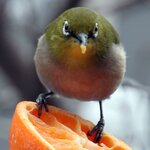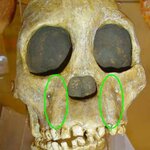Evolution

Scientists have sequenced over seventy strains of yeast, the greatest number of genomes for any species. The basic machinery of yeast is surprisingly similar to that of humans, and the project is already helping experts to develop the tools necessary for studying human genetic variation. Yeast can also be used to develop and test new drugs, such as for cancer.
It also gave us a clever way to finagle the title and remind you about Darwin Day tomorrow - the 200th anniversary of his birth. And, if you are an American Republican, it's also the 200th birthday of the first…

Show Me The Science Month Day 14
Another abstract will have to do for today's extremely delayed installment; the grant proposal leaves my desk tomorrow, so I hope to be back in business as soon as my neck recovers from days of hunching over the laptop.
Today's paper, Sequencing human–gibbon breakpoints of synteny reveals mosaic new insertions at rearrangement sites, is not just interesting because two of the senior authors work one floor below my lab, or because the other senior authors is speaking to our department on Thursday. This paper is an interesting glimpse into the chromosome…

Show Me The Science Month Day 13
The grant writing has reached a fever pitch as the deadline closes in. Tomorrow 30 Days of Evolution Blogging will get back on track, but for today, a title and abstract will have to do. Today's paper is a DNA comparison study of the class of birds known as white-eyes (the Zosteropidae), which have demonstrated an amazing capacity for evolutionary diversification.
Zosterops japonicus, Courtesy the Wikipedia Commons
Explosive Pleistocene diversification and hemispheric expansion of a “great speciator”
Robert G. Moylea,Christopher E. Filardi,Catherine E. Smith…

Show Me The Science Month Day 12
Natural selection is often much like Goldilocks - an organism's traits shouldn't be too hot or too cold; natural selection likes them just right. In other words, traits are under pressure to remain near an optimum. If they deviate too far, natural selection will not-so-gently prod things back to the center. This phenomenon is known as stabilizing selection.
Stabilizing selection has to push against another powerful evolutionary force - random drift. Much of our genetic makeup is influenced by non-adaptive processes, that is, processes that are not particularly…

Want to learn how to survive in exteme environments? A marine bacterium living 8,000 feet below the ocean's surface can show you the way.
The bacterium Nautilia profundicola, a microbe that survives near deep-sea hydrothermal vents, was found in a fleece-like lining on the backs of Pompeii worms, a type of tubeworm that lives at hydrothermal vents, and in bacterial mats on the surfaces of the vents' chimney structures.
One gene, called rgy, allows the bacterium to manufacture a protein called reverse gyrase when it encounters extremely hot fluids from the Earth's interior…

Show Me The Science Month Day 11
Imagine a world where the major source of human nutrition was beer. That may sound fantastic to some of you, but now imagine that, in this beer-world, there are no bottle openers and no twist-off caps. To get at the beer, you have to open the bottles with your teeth. Day in, day out, you're opening bottles with your teeth. If the world continued like this for a few thousand generations, how would the human jaw evolve into a better beer bottle opener?
2 million years ago, our ancestors lived in such a world. OK, so it didn't involve beer-bottles, but our…

Show Me The Science Month Day 10
A pressing grant deadline is going to keep today's evolution blog entry short, but the find is no less spectacular than yesterday's fetal proto-whale fossil. A group of researchers has discovered the fossil vertebra of the largest snake known to date. At an estimated 13 meters (about 42.6 feet) long, this monster, named appropriately Titanoboa, lived in tropical South America about 60 million years ago.
Fossils help us to recover details of the Earth's past, and not just with regard to the actual organisms themselves. Fossil palm fronds in Wyoming are clear…

A missing link in the evolution of the front claw of living scorpions and horseshoe crabs was identified with the discovery of a 390 million-year-old fossil by researchers at Yale and the University of Bonn, Germany.
The specimen, named Schinderhannes bartelsi, was found fossilized in slate from a quarry near Bundenbach in Germany, a site that yields spectacularly durable pyrite-preserved fossils — findings collectively known as the Hunsrück Slate. The Hunsrück Slate has previously produced some of the most valuable clues to understanding the evolution of arthropods – including early shrimp-…

Show Me The Science Month Day 9
In what is now central Pakistan, an eight-and-a-half foot long, pregnant aquatic mammal went belly-up, and sank to the bottom of the shallow coastal waters. 47 million years later, a huckster by the name of Duane Gish denied that such mammals ever existed:
There simply are no transitional forms in the fossil record between the marine mammals and their supposed land mammal ancestors . . . It is quite entertaining, starting with cows, pigs, or buffaloes, to attempt to visualize what the intermediates may have looked like. Starting with a cow, one could even…

My Dear Mr. Darwin,
Happy 200th birthday! I hope you are as well as can expected for someone who has been dead for nearly 130 years. I suppose that your final book, the one about earthworms, has a special significance for you these days. Are the worms of Westminster Abbey superior to the ones you studied so carefully in the grounds of your home at Downe in Kent? They’ve certainly mulched some distinguished people over the years!
But enough of the personal questions: let me introduce myself. I am one of thousands – maybe tens of thousands – of professional biologists who work full time…